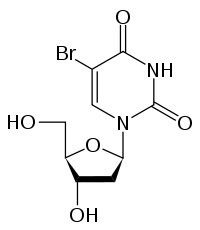Bromodeoxyuridine
 | |
| Identifiers | |
|---|---|
| 3D model (JSmol) |
|
| ChemSpider | |
| ECHA InfoCard | 100.000.378 |
| MeSH | Bromodeoxyuridine |
| PubChem CID |
|
| UNII | |
| |
| |
| Properties | |
| C9H11BrN2O5 | |
| Molar mass | 307.10 g·mol−1 |
| Except where otherwise noted, data are given for materials in their standard state (at 25 °C [77 °F], 100 kPa). | |
| | |
| Infobox references | |
Bromodeoxyuridine (5-bromo-2'-deoxyuridine, BrdU, BUdR, BrdUrd, broxuridine) is a synthetic nucleoside that is an analog of thymidine. BrdU is commonly used in the detection of proliferating cells in living tissues.[1] 5-Bromodeoxycytidine is deaminated to form BrdU.[2]
BrdU can be incorporated into the newly synthesized DNA of replicating cells (during the S phase of the cell cycle during which DNA is replicated), substituting for thymidine during DNA replication. Antibodies specific for BrdU can then be used to detect the incorporated chemical (see immunohistochemistry), thus indicating cells that were actively replicating their DNA. Binding of the antibody requires denaturation of the DNA, usually by exposing the cells to acid or heat.[3]
BrdU can be passed to daughter cells upon replication.[4] BrdU has been demonstrated to be detectable over two years post-infusion.[5]
Because BrdU can replace thymidine during DNA replication, it can cause mutations, and its use is therefore potentially a health hazard.[3] However, because it is neither radioactive nor myelotoxic at labeling concentrations, it is widely preferred for in vivo studies of cancer cell proliferation.[6][7] However, at radiosensitizing concentrations, BrdU becomes myelosuppressive, thus limiting its use for radiosensitizing.[2]
BrdU differs from thymidine in that BrdU substitutes a bromine atom for thymidine's CH3 group. The Br substitution can be used in X-ray diffraction experiments in crystals containing either DNA or RNA. The Br atom acts as an anomalous scatterer and its larger size will affect the crystal's X-ray diffraction enough to detect isomorphous differences as well.[8][9]
Bromodeoxyuridine releases gene silencing caused by DNA methylation.[10]
BrdU can also be used to identify microorganisms that respond to specific carbon substrates in aquatic[11] and soil [12] environments. A carbon substrate added to incubations of environmental samples will cause the growth of microorganisms that can utilize that substrate. These microorganisms will then incorporate BrdU into their DNA as they grow. Community DNA can then be isolated and BrdU-labeled DNA purified using an immunocapture technique.[13] Subsequent sequencing of the labeled DNA can then be used to identify the microbial taxa that participated in the degradation of the added carbon source.
However, it is not certain whether all microbes present in an environmental sample can incorporate BrdU into their biomass during de novo DNA synthesis. Therefore, a group of microorganisms may respond to a C source but go undetected using this technique. Additionally, this technique is biased towards identifying microorganisms with A- and T-rich genomes.
See also
References
- ↑ Lehner, Bernadette; Sandner, Beatrice; Marschallinger, Julia; Lehner, Christine; Furtner, Tanja; Couillard-Despres, Sebastien; Rivera, Francisco J.; Brockhoff, Gero; Bauer, Hans-Christian; Weidner, Norbert; Aigner, Ludwig (2011). "The dark side of BrdU in neural stem cell biology: Detrimental effects on cell cycle, differentiation and survival". Cell and Tissue Research. 345 (3): 313–28. PMID 21837406. doi:10.1007/s00441-011-1213-7.
- 1 2 Russo A, Gianni L, Kinsella TJ, Klecker RW, Jenkins J, Rowland J, Glatstein E, Mitchell JB, Collins J, Myers C (1984). "Pharmacological evaluation of intravenous delivery of 5-bromodeoxyuridine to patients with brain tumors". Cancer Res. 44 (4): 1702–5. PMID 6704976.
- 1 2 Konishi, Teruaki; Takeyasu, Akihiro; Natsume, Toshiyuki; Furusawa, Yoshiya; Hieda, Kotaro (2011). "Visualization of Heavy Ion Tracks by Labeling 3'-OH Termini of Induced DNA Strand Breaks". Journal of Radiation Research. 52 (4): 433–40. PMID 21785232. doi:10.1269/jrr.10097.
- ↑ Kee, N; S Sivalingam; R Boonstra; J.M Wojtowicz (March 2002). "The utility of Ki-67 and BrdU as proliferative markers of adult neurogenesis". Journal of Neuroscience Methods. 115 (1): 97–105. PMID 11897369. doi:10.1016/S0165-0270(02)00007-9.
- ↑ Eriksson, Peter; Ekaterina Perfilieva; Thomas Björk-Eriksson; Ann-Marie Alborn; Claes Nordborg; Daniel A. Peterson; Fred H. Gage (1998). "Neurogenesis in the adult human hippocampus". Nature Medicine. 1313-1317. 4 (11): 1313–1317. PMID 9809557. doi:10.1038/3305.
- ↑ Fujimaki, Takamitsu; Masao Matsutani; Osamu Nakamura; Akio Asai; Nobuaki Funada; Morio Koike; Hiromu Segawa; Kouichi Aritake; Takanori Fukushima; Shuntaro Houjo; Akira Tamura; Keiji Sano (29 June 2006). "Correlation Between Bromodeoxyuridine- Labeling Indices and Patient Prognosis in Cerebral Astrocytic Tumors of Adults". Cancer. 67 (6): 1629–1634. PMID 2001552. doi:10.1002/1097-0142(19910315)67:6<1629::AID-CNCR2820670626>3.0.CO;2-E.
- ↑ Hoshino, Takao; Tadashi Nagashima; Judith Murovic; Ellen M. Levin; Victor A. Levin; Stephen M. Rupp (1985). "Cell Kinetic Studies of In Situ Human Brain Tumors With Bromodeoxyuridine". Cytometry. 6 (6): 627–632. PMID 2998714. doi:10.1002/cyto.990060619.
- ↑ Peterson, M. R.; Harrop, S. J.; McSweeney, S. M.; Leonard, G. A.; Thompson, A. W.; Hunter, W. N.; Helliwell, J. R. (1996). "MAD Phasing Strategies Explored with a Brominated Oligonucleotide Crystal at 1.65Å Resolution". Journal of Synchrotron Radiation. 3 (Pt 1): 24–34. PMID 16702655. doi:10.1107/S0909049595013288.
- ↑ Beck, Tobias; Gruene, Tim; Sheldrick, George M. (2010). "The magic triangle goes MAD: Experimental phasing with a bromine derivative". Acta Crystallographica Section D. 66 (4): 374–80. PMC 2852301
 . PMID 20382990. doi:10.1107/S0907444909051609.
. PMID 20382990. doi:10.1107/S0907444909051609. - ↑ Weiss RA (2013). "On the concept and elucidation of endogenous retroviruses". Philos. Trans. R. Soc. Lond., B, Biol. Sci. 368 (1626): 20120494. PMC 3758183
 . PMID 23938748. doi:10.1098/rstb.2012.0494.
. PMID 23938748. doi:10.1098/rstb.2012.0494. - ↑ Tada, Yuya; Grossart, Hans-Peter (2013). "Community shifts of actively growing lake bacteria after N-acetyl-glucosamine addition: improving the BrdU-FACS method". The ISME Journal. 8 (2): 441–454. ISSN 1751-7362. doi:10.1038/ismej.2013.148.
- ↑ Borneman J (1999). "Culture-independent identification of microorganisms that respond to specified stimuli". Appl. Environ. Microbiol. 65 (8): 3398–400. PMC 91510
 . PMID 10427025.
. PMID 10427025. - ↑ Urbach, Ena; Kevin L. Vergin; Stephen J. Giovannoni (March 1999). "Immunochemical Detection and Isolation of DNA from Metabolically Active Bacteria". Applied and Environmental Microbiology. pp. 1207–1213.